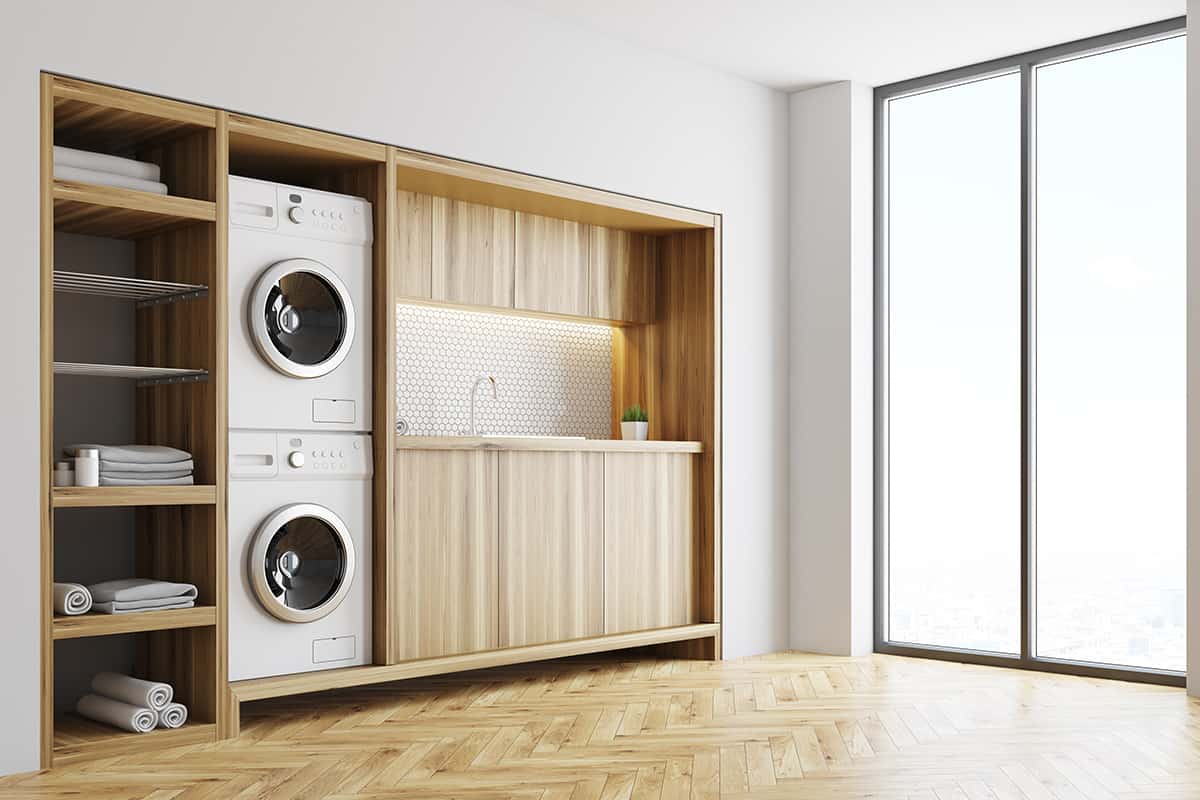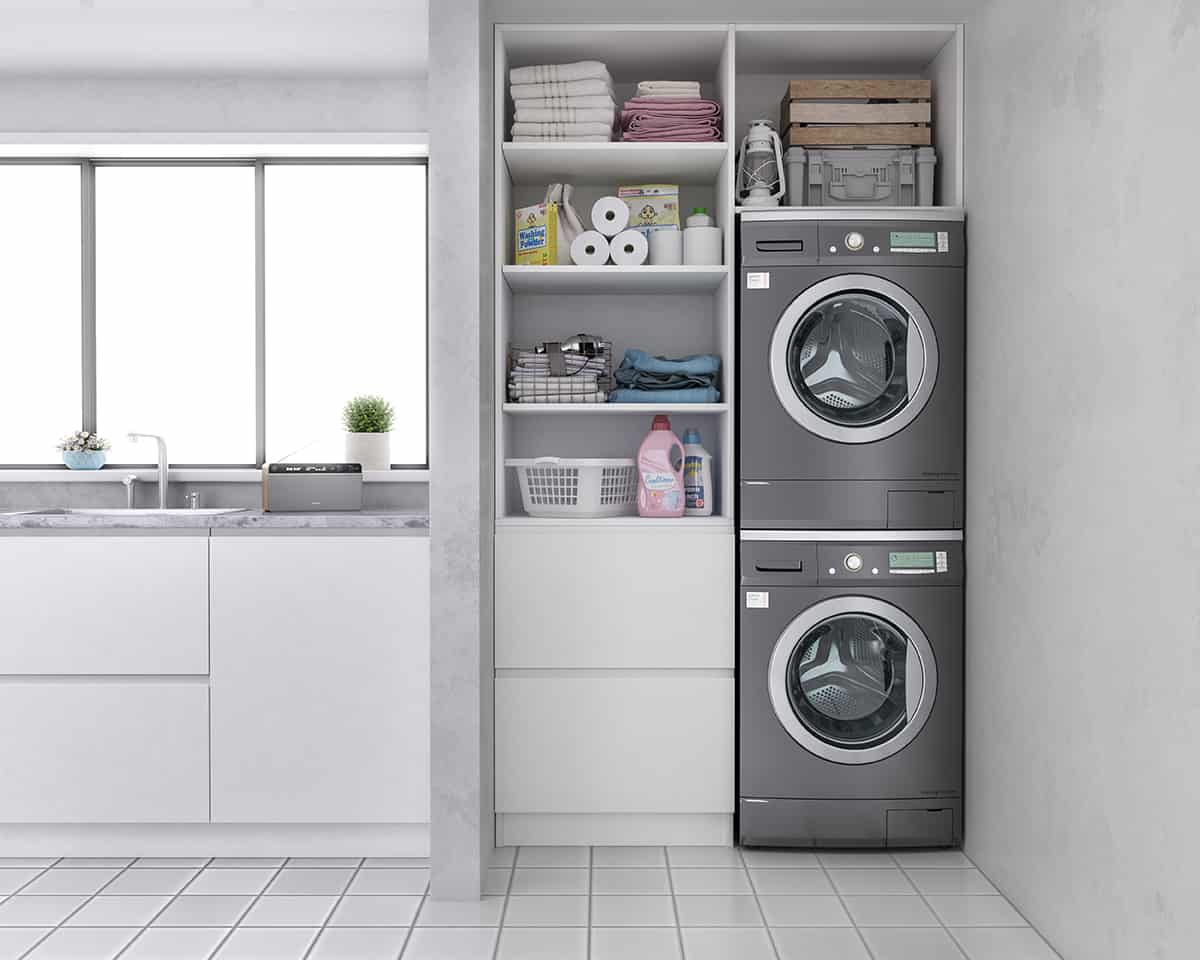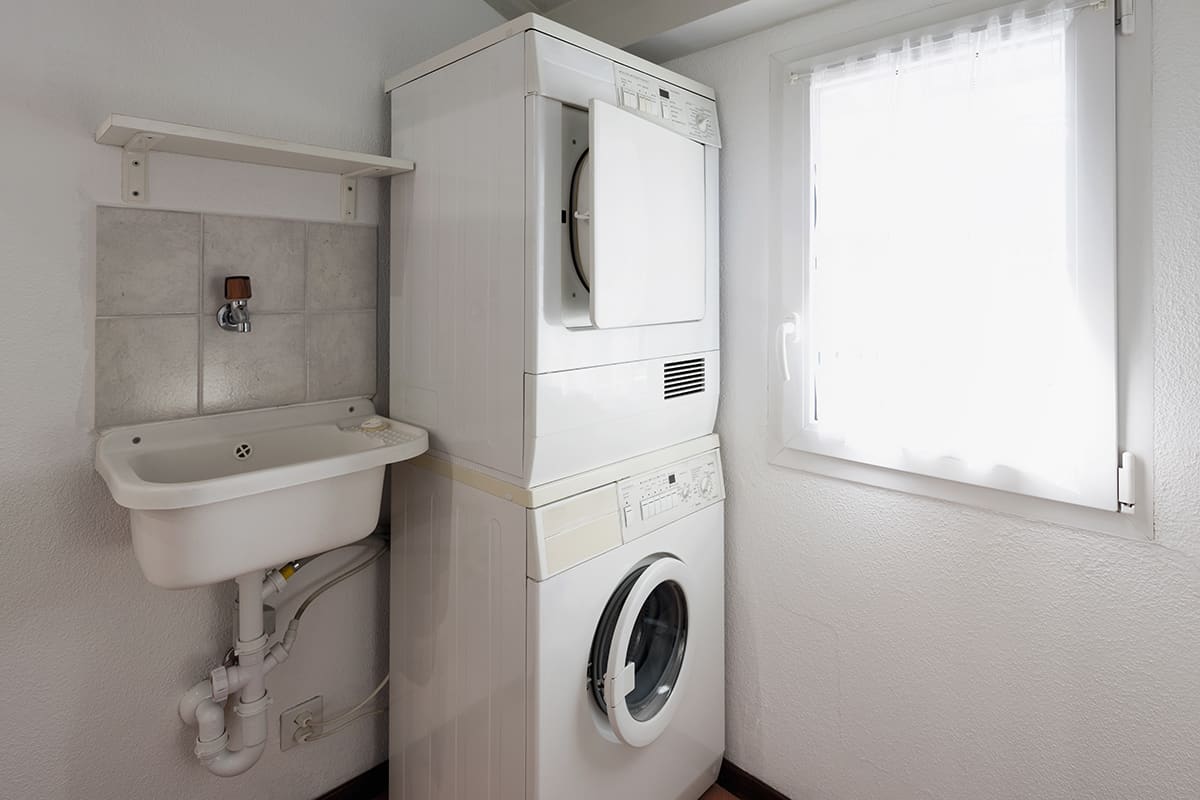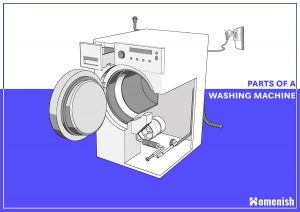If you’re wondering how to stack a washer and dryer without a kit, we’re going to tell you exactly how it’s done.
The first thing you’ll need is some kind of platform that will support the weight of both machines. In most cases, we recommend getting one with wheels so that it can be pulled out when needed (and pushed back into place when not).
If possible, choose wood or metal over plastic—the former options are more durable! It should also include shelving for clothes hangers if possible. Keep reading for a detailed step-by-step guide.
Step-by-step to Stack a Washer and Dryer Without a Kit
Turn Off Power to the Washer and Dryer
- Turn off power to the washer and dryer.
- How you do this depends on the model, but generally, it involves flipping a switch in an electrical panel or breaker box.
Unplug the Washer and Dryer
It’s time to unplug the washer and dryer. To do this, you need to first locate the outlet that powers your washer and dryer. This can often be found in a closet near where you keep your laundry appliances. Unplug the appliance from its power source before continuing with this project.
If you cannot reach the outlet, turn off the power to it at the circuit breaker panel. Make sure that no one else needs access to electricity while working on this step of the process: turning off the power is an important step in preventing accidents such as electrocution or fires caused by frayed wires!
Place a Wood Plank on Top of the Dryer
Next, place a wood plank on top of the dryer. The plank should be 1.5 inches thick and the same width as your dryer. Measure and mark your plank, then cut it with a circular saw or table saw.
You can also use plywood instead, which is much easier to work with than solid wood boards, but you’ll need two sheets of 3/4-inch plywood (one for each side) because dimensional lumber tends not to be wide enough for this project.
Once you’ve cut the planks for both sides of the washer and dryer stack, set them aside until later when we come back after installing our flooring material so we can measure our baseboards accordingly.
Place Stacking Brackets on Top of the Plank
Place stacking brackets on top of the plank and then place the plank on top of the dryer and use wood glue to secure it into place. Clamp it down with some clamps until it dries so that they’ll stop slipping off while you’re moving around the machine.
Move the Washer into Position
After you’ve assembled your wooden platform and moved the dryer into place, it’s time to get the washer in position. Here are some tips on how to do so:
- Use a dolly or cart to move the washer. If you don’t have one, enlist a friend’s help to move it by hand (but make sure they’re strong enough).
- Make sure the wheels on your machine are locked—this will ensure that it doesn’t suddenly roll away from you while you’re moving it into place.
- Check that your machine is stable before continuing with this step; if it isn’t, add shims underneath the corners of your wooden platform until each corner has at least two inches of support below them (or four inches if possible).
This can be done with anything from large pieces of cardboard or plywood to bricks or concrete blocks (as long as they don’t damage your flooring).
You could also build up extensions on either side of one side of your platform as well and rest more weight there instead by placing larger gears onto those extensions and resting them against something solid like an outside wall or another piece of furniture inside your house, like a couch, table, lamp, etc.
Slide the Dryer Over the Washer and Onto the Brackets
Once the dryer is in position, use a hand truck to pull the dryer over it. As you pull the dryer forward, make sure it’s centered over the washer so that it sits squarely on top of them both. Don’t drop it!
Use Screws to Secure It in Place
To make sure that your washer and dryer are safe and secure, you’ll want to use a power drill to attach them together. The screws need to be long enough that they can go through both the washer and dryer, so you’ll want something like an 11/16″ screw.
You should also use a level on top of your cabinets or flooring before putting any screws in place; this will ensure that everything is secure once it’s all done.
Once you have secured your washer and dryer with screws, it’s time for the final step: checking for studs in the wall before drilling holes for mounting brackets!
Can You Just Stack Any Washer and Dryer?
You’re ready to buy a washer and dryer, but you want to make sure they’ll fit in your space.
Should you just get any old stackable unit? Or should you look for a specific type? The answer is that there are several types of stacked washers and dryers on the market, and those differences can affect how well or easily the units stack together.
If two machines were not designed specifically for stacking, then it may not be as easy or stable when assembled. But if both were made with stacking in mind, then assembly should be quick and easy.
Yes, you can – but you might not want to
You can stack a washer and dryer that aren’t designed to be stacked if you have the right tools and know-how. But it is not recommended because there are many factors that could cause problems for you down the line.
The first thing to consider is whether or not your particular model of washer and dryer is capable of being stacked in the first place.
You will need to check your owner’s manual and look for information about stacking, or take a picture of both units together with their serial numbers visible so you can match them up later if necessary. If there’s no mention of stacking anywhere in either manual, then don’t do it!
If all looks good on paper (or on-screen), then read through all instructions carefully before attempting anything else. It may seem like common sense at first glance, but there are some things that can go wrong if you don’t follow directions closely—like damaging electronic components or causing gas leaks or water leaks when connecting hoses incorrectly. Don’t forget this step either!
When It Makes Sense to Stack a Particular Washer and Dryer
The reason it makes sense to stack a particular washer and dryer is that they’re made to be stacked. The height of the washer and dryer match up perfectly, so there’s no need for an extension kit or other modifications.
For example, the door of the dryer opens on the side, while that of your new front-loading washer has been designed with a lip on its backside to accommodate stacking.
All you’ll need is included in your purchase: two adjustable brackets (one for each appliance), screws for mounting them onto your floor, four clips for attaching those brackets to each appliance (two per appliance), and some clear instructions from the manufacturer.
If you’re not handy enough on your own, ask at home improvement stores if they offer installation services—they may do this as part of their offerings.
Buy a kit if you need one
You can also buy kits that will convert your old washer and dryer into a stackable set by making the washer higher and the dryer lower. You need to check that your washer and dryer are compatible with these kits, however, as not all models are.
If you decide to go this route, make sure that you get the right parts before ordering anything!
If you have an older model of one or both appliances (an old Maytag, perhaps), it’s best to look into purchasing new machines rather than trying to convert them.
Newer models come with features like auto-off sensors and energy-efficient modes, which will help save money on electricity bills over time because they’re more efficient at doing their jobs than older models were.
Always Check the Owner’s Manual
While it’s generally safe to stack washer and dryer units, you should always check the owner’s manual for your appliances before adding any additional components to them.
If the manufacturer has approved stacking, then it will be in the owner’s manual. You can also call the manufacturer directly if you’re still not sure about compatibility.
Are There Any Downsides to Stacking the Washer and Dryer?
Since both washers and dryers are generally not designed to be stacked, there are some downsides to doing it. For example:
- You may have to bend down a bit more than normal to reach the controls on your dryer. Or if someone is short or in a wheelchair, it’s hard to reach the dryer.
- If you have a ventless dryer, you’ll need to make sure that there’s enough space above it for ventilation purposes (check with your local building codes).
- If you’re trying to get clothes in and out of the dryer, it could be slightly harder than usual because of their close proximity.
What Makes a Washer Stackable?
- A front-loading washer.
- It must be designed to stack (some manufacturers make models specifically for stacking).
- Most front-loaders are not designed to stack, so this is a big hurdle. If you have a top-load washing machine and want to save space in your laundry room, consider buying a stacking kit instead of a front loader that can be stacked.








